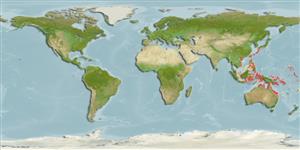Environment: milieu / climate zone / depth range / distribution range
Écologie
marin benthopélagique; profondeur 0 - 6 m (Ref. 75058). Subtropical
Western Pacific: southern Japan to Indonesia.
Taille / Poids / Âge
Maturity: Lm ? range ? - ? cm
Max length : 18.6 cm SL mâle / non sexé; (Ref. 75058); 13.1 cm SL (female)
Description synthétique
Clés d'identification | Morphologie | Morphométrie
Épines dorsales (Total) : 5; Rayons mous dorsaux (Total) : 21 - 22; Épines anales: 1; Rayons mous anaux: 17 - 18. This species is distinguished by the following: pectoral fin rays usually 18; cheek region with brown semicircular or M-shaped band and many blackish spots; lower portion of the
body in males with 3-4 ocelli and several blackish and brownish spots; usually 1-2 A1-2 and A2-3 spots, 2-3 A' series spots, and B4 spot, and a series of 6-7 ocelli on the lower portion of the body with brownish spots or patches between them present in females and juveniles (Ref. 75058).
Life cycle and mating behavior
Maturité | Reproduction | Frai | Œufs | Fécondité | Larves
Imamura, H. and T. Yoshino, 2007. Three new species of the genus Parapercis from the Western Pacific, with Rediscription of Parapercis hexophtalma (Perciformes:Pinguipedidae). Bull. Natl. Mus. Nat. Sci. Ser. A, Suppl. 1:81-100. (Ref. 75058)
Statut dans la liste rouge de l'IUCN (Ref. 130435: Version 2024-2)
Menace pour l'homme
Harmless
Utilisations par l'homme
Outils
Articles particuliers
Télécharger en XML
Sources Internet
Estimates based on models
Preferred temperature (Ref.
123201): 25.1 - 29.3, mean 28.7 °C (based on 956 cells).
Phylogenetic diversity index (Ref.
82804): PD
50 = 0.5000 [Uniqueness, from 0.5 = low to 2.0 = high].
Bayesian length-weight: a=0.00692 (0.00314 - 0.01524), b=3.06 (2.88 - 3.24), in cm total length, based on LWR estimates for this Genus-body shape (Ref.
93245).
Niveau trophique (Ref.
69278): 3.6 ±0.4 se; based on size and trophs of closest relatives
Résilience (Ref.
120179): Haut, temps minimum de doublement de population inférieur à 15 mois (Preliminary K or Fecundity.).
Fishing Vulnerability (Ref.
59153): Low vulnerability (13 of 100).
Nutrients (Ref.
124155): Calcium = 131 [69, 262] mg/100g; Iron = 0.978 [0.534, 1.795] mg/100g; Protein = 17.6 [15.4, 19.5] %; Omega3 = 0.194 [0.094, 0.391] g/100g; Selenium = 15.4 [7.1, 35.4] μg/100g; VitaminA = 28.2 [8.1, 99.5] μg/100g; Zinc = 1.17 [0.77, 1.75] mg/100g (wet weight);
